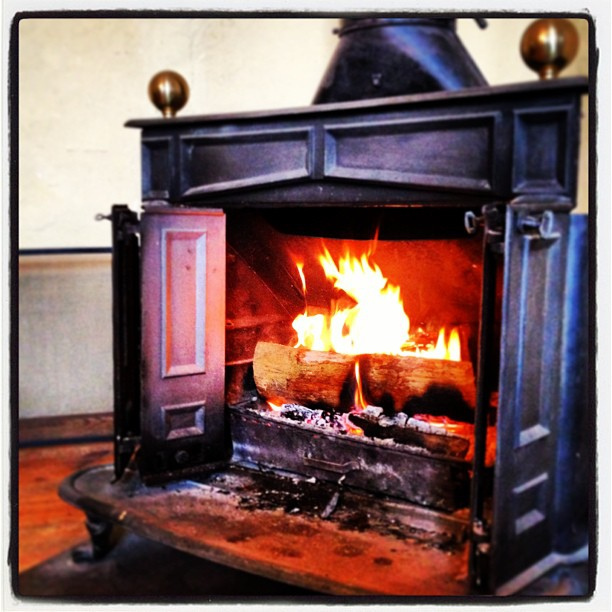The **Benjamin Franklin stove** stands as a remarkable testament to Franklin’s ingenuity, emerging during a time of extreme climate challenges in the 18th century. This innovative heater was designed by Franklin to improve domestic comfort by maximizing heat while minimizing wood consumption, reflecting his forward-thinking approach to climate adaptation technology. As historian Joyce Chaplin reveals in her compelling biography of Benjamin Franklin and his inventions, the stove not only revolutionized home heating but also played a pivotal role in advancing the history of American science. Franklin’s work on this stove provides a fascinating insight into how inventions can influence public understanding of environmental phenomena, such as atmospheric conditions and their effects on daily life. Thus, the Franklin stove serves as a crucial link between historical invention and modern science, highlighting Franklin’s enduring impact on the world.
Also known as the Pennsylvania fireplace, the **Franklin stove** is one of the lesser-discussed but significant contributions of Benjamin Franklin. This innovative heating device, designed for greater efficiency and warmth, not only provided solace during harsh winters but also prompted new discussions on sustainability and weather science. It reflects a broader theme of Franklin’s inventions, which showcase his role as a visionary in the history of American technology. By examining the benefits of this stove, we gain deeper insight into Franklin’s profound understanding of the environment, as well as the historical context that motivated his quest for improved domestic life. Ultimately, the influence of this practical invention continues to resonate in today’s discourse on climate adaptation and energy efficiency.
The Historical Significance of Benjamin Franklin’s Innovations
Benjamin Franklin is often hailed as one of the most influential figures in early American history, primarily due to his wide array of inventions and contributions to science and politics. His innovative spirit was rooted in the Enlightenment ideals of inquiry and improvement, which allowed him to connect theoretical science with practical applications. Among his most significant contributions is the Franklin stove, a remarkable piece of climate adaptation technology that revolutionized home heating during a time of severe environmental challenges. This invention exemplifies Franklin’s understanding of atmospheric phenomena, an area he explored through rigorous experimentation and observation.
The significance of Franklin’s work extends beyond the stove; it embodies the progressive spirit of the time. His inventions, alongside his mapping of the Gulf Stream, helped lay the foundation for the burgeoning field of meteorology and the study of climate. Scholars, including historian Joyce Chaplin, stress how Franklin’s scientific pursuits were not merely academic but crucial for addressing the pressing challenges of his era, such as the harsh winters of 1740-1741 that led to dire consequences, including famine, exacerbating the need for efficient heating solutions. By drawing connections between his inventions and the environmental concerns of his time, we gain insights into the history of American science and its evolution.
Understanding the Franklin Stove: A Technological Marvel
The Franklin stove represents a significant technological advancement in the 18th century, merging design and function to improve home heating efficiency. Unlike traditional fireplaces, the Franklin stove was designed to burn wood and coal more effectively, producing more heat while using less fuel. This innovation not only provided greater comfort but also addressed the environmental issues posed by deforestation and rising fuel costs in a growing colonial society. Franklin’s design was a testament to his forward-thinking approach, as he sought to create a comfortable indoor environment even amidst the challenges of a harsh climate.
Moreover, the stove’s introduction marked a shift in how people interacted with their environment, reflecting broader trends in climate adaptation technology. Franklin’s emphasis on convection—the movement of warm air—illustrated his deep understanding of physical principles that govern heating, which he cleverly applied to both his stove and broader atmospheric phenomena. By creating a heating system that mimicked natural processes, Franklin not only enhanced individual comfort but also offered insights into the interconnectivity of human inventions and natural forces, making the Franklin stove a cornerstone of his legacy and a case study in early American innovation.
Joyce Chaplin’s Exploration of Franklin’s Impact on Science
Historian Joyce Chaplin’s examination of Benjamin Franklin’s contributions intersects the realms of history, science, and technology. In her recent work, ‘The Franklin Stove: An Unintended American Revolution,’ she delves into how Franklin’s inventions, particularly the stove, catalyzed new thoughts on weather and environment. Chaplin connects Franklin’s scientific endeavors to the severe climate adaptations necessitated by the Little Ice Age, emphasizing the impact of frigid temperatures on colonial life. Her analysis underscores how Franklin’s inventions were not only practical solutions but also transformative ideas that challenged existing perspectives on human comfort and environmental interaction.
Chaplin further articulates the implications of Franklin’s work, highlighting how his stove was meant for more than just heat production; it represented a broader inquiry into mankind’s ability to manipulate nature for better living conditions. This inquiry reflects the historical context of American science, as emerging inventors and scientists explored the relationship between innovation and environmental adaptation. Chaplin’s insights remind us that Franklin’s legacy is intertwined with the growth of scientific understanding, underscoring the role of intellectual figures in shaping the history of early American science.
Franklin’s Influence on Modern Environmental Thought
Franklin’s visionary approach to technology has reverberated into contemporary discussions surrounding climate change and environmental responsibility. His insightful designs, particularly around reducing emissions from his stove, showcase an early acknowledgment of the environmental impact of fossil fuels, especially coal. As today’s society grapples with the consequences of climate change, revisiting Franklin’s solutions can provide valuable lessons. His experiments demonstrated that efficiency in technology could lead to less waste and improved air quality—principles that are critical as we seek sustainable alternatives in our current energy practices.
The ideas put forward by Franklin resonate deeply amid today’s techno-optimism, where many believe that innovation alone can resolve climate issues. Chaplin’s work encourages a reflective stance on this perspective, suggesting that Franklin’s successes were not isolated but part of a broader narrative of collective human ingenuity. The challenges we face today cannot be solved by a single invention or quick fix; rather, they require collaborative efforts that incorporate diverse solutions, much like Franklin’s multifaceted approach to inventing. By studying Franklin’s legacy, we can glean the importance of ongoing adaptation and the necessity for innovative thinking in the face of climate uncertainties.
The Legacy of the Franklin Stove in American History
The Franklin stove, while often regarded as one of Franklin’s lesser-known inventions, is a crucial part of American history that reflects the spirit of innovation during its time. Its design not only catered to immediate heating needs but also laid the groundwork for future heating technologies. This stove symbolizes Franklin’s deep understanding of thermal dynamics and his desire to enhance the comfort of his fellow colonists, positioning him as a precursor to modern environmentalism and climate adaptation technology. Over the years, its influence can be seen in the development of more sophisticated heating systems, showcasing the evolution of residential warmth through continuous innovation.
Moreover, as we analyze the legacy of the Franklin stove, it’s essential to recognize how Franklin’s inventions continue to inspire modern thinkers and innovators. The stove’s ability to use resources more efficiently is a principle echoed in today’s sustainable design practices. Franklin’s early focus on creating solutions that connected human needs with environmental considerations paved the way for the dialogue surrounding energy efficiency and sustainability that we engage in today. Consequently, the Franklin stove stands as a testament to Franklin’s enduring impact on American science, encapsulating a legacy that encourages future generations to blend innovation with environmental consciousness.
Benjamin Franklin: Inventor and Figure in Climate History
As a multifaceted figure, Benjamin Franklin’s contributions to science went beyond mere inventions. His work in mapping the Gulf Stream was revolutionary and laid the groundwork for understanding oceanic currents and their influence on climate. This was particularly pertinent during a period marked by extreme weather events, where his inventions, such as the Franklin stove, illustrated his proactive mindset toward climate-related challenges. Franklin’s ability to connect meteorological phenomena with practical home solutions highlights his role not only as an inventor but also as an early thinker in the discourse on environmental science.
Franklin’s engagements with climate issues can be seen as an early effort to utilize science for societal benefit, positioning him as a forerunner in climate adaptation discourse. Historian Joyce Chaplin’s analysis emphasizes how Franklin navigated the environmental concerns of his time, creating advancements that echoed the growing awareness of human impact on nature. His inventions, viewed through a modern lens, underscore the importance of integrating scientific understanding with practical applications for addressing climate issues—a theme that remains relevant today as climate change continues to challenge our capacities for innovation.
The Franklin Stove and Its Role in Domestic Comfort
The Franklin stove not only revolutionized heating methods but also significantly impacted domestic comfort in colonial America. By focusing on efficient heat distribution, Franklin redefined what it meant to stay warm during harsh winters, transforming homes into sanctuaries against the cold. The stove’s design allowed for better air circulation, utilizing principles of convection to ensure that heat was distributed evenly. This innovation not only enhanced living conditions but reinforced the importance of a comfortable home, which was central to the family and community life of the time.
Moreover, Franklin’s approach to domestic technology highlights the intersection between comfort and environmental awareness. His understanding of how air and heat interacted played a significant role in mitigating the adverse effects of winter climates, demonstrating a blend of practicality and scientific inquiry. His contributions remind us how technological advancements can serve both immediate human needs and broader environmental considerations. The Franklin stove thus stands as a symbol of Franklin’s commitment to improving daily life through innovative science, echoing the ongoing quest for comfort and efficiency in our own lives.
Exploring the Scientific Principles Behind the Franklin Stove
At its core, the Franklin stove represents a fascinating application of scientific principles to everyday living. Franklin’s exploration into convection illustrates how heated air behaves when subjected to various conditions, enabling him to design a stove that would effectively warm a room. His pamphlets explained complex ideas in accessible terms, helping the public grasp the fundamental concepts of thermal dynamics. This approach not only educated his audience but also instilled an appreciation for science, encouraging a culture of inquiry and experimentation that characterized much of the 18th-century American intellect.
Franklin’s interest in atmospheric phenomena further enriched his understanding of heat distribution. By relating the actions of his stove to larger environmental patterns, such as storm movements and the Gulf Stream, he manifested a vision where technology and nature coexisted harmoniously. His ability to draw these connections underscores his role as a pioneer in the field of environmental science, demonstrating that domestic inventions could have far-reaching implications. Today, as we seek to enhance energy efficiency, Franklin’s methodologies continue to inspire innovators and scientists committed to marrying technology with ecological mindfulness.
The Cultural Impact of Franklin’s Innovations
The cultural impact of Benjamin Franklin’s innovations cannot be overstated, with effects reverberating through subsequent generations. The Franklin stove, as part of his multitude of inventions, epitomizes the spirit of self-improvement and ingenuity that defined the American character during the Revolutionary era. Franklin’s ability to bridge scientific practices with everyday life fostered a culture that valued knowledge and its applications, encouraging Americans to engage with science beyond mere academic interest. Each invention reflected a commitment to improving the human condition, making science accessible and beneficial.
Moreover, the legacy of Franklin’s innovations illustrates the evolution of American identity marked by the quest for comfort and efficiency. Franklin’s determination to address heating issues during the Little Ice Age highlighted the resilience and adaptability of the early American populace. His cultural influence persists today, encouraging contemporary society to prioritize innovation in tackling modern challenges, such as climate change. This legacy reinforces the notion that the pursuit of science, grounded in practical applications, remains a cornerstone of American ingenuity and historical narrative.
Frequently Asked Questions
What is the significance of the Benjamin Franklin stove in the history of American science?
The Benjamin Franklin stove is significant in the history of American science as it represents Franklin’s innovative approach to climate adaptation technology during the harsh winter of 1740-1741. Designed to improve heating efficiency, this stove utilized the principles of convection to warm rooms more effectively, thus influencing both indoor air quality and outdoor atmospheric phenomena.
How did Benjamin Franklin’s stove relate to atmospheric phenomena?
Benjamin Franklin’s stove contributed to the understanding of atmospheric phenomena by demonstrating how warmed air rises and creates a draft. Franklin used this concept to explain storm systems and even mapped the Gulf Stream’s movements, showcasing his scientific contributions that interconnected indoor heating with broader environmental science.
What were the economic and environmental motivations behind Benjamin Franklin’s stove invention?
Benjamin Franklin’s invention of the stove was motivated by environmental concerns during a cold winter that led to resource scarcity. He aimed to create a more efficient heating solution that would reduce wood consumption, thus addressing both economic challenges faced by settlers and the environmental impact of deforestation as populations grew.
In what ways did Joyce Chaplin’s research on the Franklin stove explore Franklin’s lesser-known contributions?
Joyce Chaplin’s research on the Franklin stove highlights Benjamin Franklin’s lesser-known contributions to climate adaptation technology, revealing his forward-thinking approach to both science and comfort. It connects his invention to his broader works as a scientist and inventor, showcasing how a humble design catalyzed new ways of thinking about technology’s impact on daily life and the environment.
What did Benjamin Franklin hope to achieve with his designs for the stove and its emissions reduction features?
Benjamin Franklin aimed to minimize air pollution with his stove designs by creating a system that re-burned smoke, thus improving fuel efficiency and reducing harmful emissions. His concern with air quality and health indicated an early awareness of environmental issues, aligning with contemporary concerns about emissions and their effects.
Can you explain the role of the Franklin stove in the narrative of 18th-century American innovations?
The Franklin stove serves as a crucial narrative point in the story of 18th-century American innovations as it encapsulates Franklin’s blend of practicality and scientific inquiry. It reflects the period’s spirit of experimentation and adaptation, highlighting how one invention can lead to advancements in technology and an enhanced understanding of both human comfort and environmental systems.
How does the Franklin stove connect to modern discussions on energy and climate solutions?
The Franklin stove connects to modern discussions on energy and climate solutions by illustrating the importance of innovation amid climate challenges. It emphasizes the need for diverse approaches to energy efficiency and environmental responsibility, cautioning against relying on single solutions in the quest for sustainable living, akin to today’s mixed strategies in combating climate change.
| Key Point | Details |
|---|---|
| Author | Joyce Chaplin, historian and professor of Early American History. |
| Invention Focus | Benjamin Franklin’s stove, designed to improve heating and reduce wood usage. |
| Historical Context | Developed during the Little Ice Age, particularly the harsh winter of 1740-41. |
| Scientific Contribution | Franklin’s stove helped advance understanding of atmospheric phenomena like the Gulf Stream. |
| Design Features | Utilizes convection to heat rooms efficiently, |
| Environmental Awareness | Franklin aimed to minimize smoke emissions and improve air quality. |
| Legacy | The Franklin stove reflects Enlightenment thinking and innovative problem-solving in the face of climate challenges. |
Summary
The Benjamin Franklin stove is a remarkable invention that demonstrates Franklin’s ingenuity and awareness of climate challenges during his time. This innovative heating solution not only improved comfort by maximizing warmth and minimizing wood usage but also contributed to advancements in atmospheric science. By understanding how his design could impact air quality and environmental conditions, Franklin laid the groundwork for future generations to think critically about technology’s role in addressing climate issues. As we reflect on his contributions, the lessons of the Franklin stove remain relevant today, reminding us of the importance of sustainable practices in our efforts to navigate contemporary environmental challenges.



